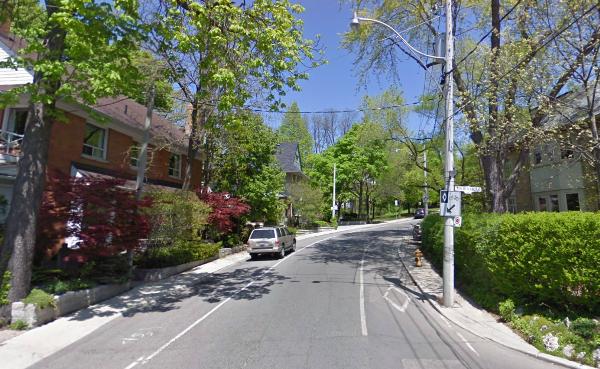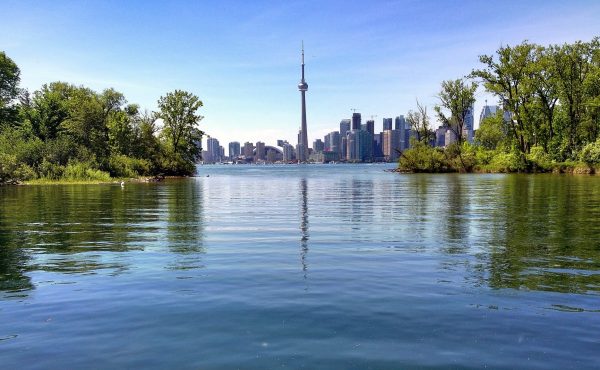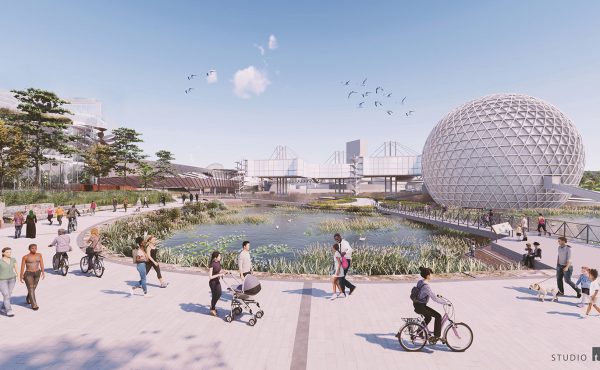It’s often touted among cycling advocates in our city that there was a time when Toronto ranked as North America’s #1 cycling city. One could say it all started with the installation of the City’s first bike lane on Poplar Plains in 1979 (photo above). In more recent years, progress on this front has been slow, and in some cases we’ve even seen regression. Though a lot of progress was made in the past decade or so, a lot of what you see on Toronto’s streets was implemented prior to the city’s amalgamation.
An article in the Toronto Star last week got me thinking about what path Toronto could be on had we not amalgamated.
In Montreal, the borough of Le Plateau-Mont Royal is facing some backlash to the Mayor’s recent changes to the area’s streets. New bike routes and traffic calming are funneling through-traffic off of local streets and onto major thoroughfares. According to some shop owners, the increase in traffic congestion along these routes is bad for business. I personally extol the livability as well as financial benefits of street planning that caters more to patrons who arrive by foot, bike and public transit, rather than private car (see my research here and recent developments in Portland). However, some Plateau merchants claim that these street changes have so strongly impacted their businesses’ bottom line that many shops have already had to close.
“I’m dying here,” says Manny, who prefers not to use his real name lest the city retaliate. He has been retailing there for 35 years. “We’re all dying.”
Buffeted by recession, rising taxes, climbing rents, proliferating big-box stores with their free parking, and now, new traffic-calming measures, similar to what Toronto instituted in some neighbourhoods more than a dozen years ago, shopkeepers say they’re fighting for their lives. The merchants’ association said Friday that business has dropped as much as 35 per cent for some stores over the last two years.
Regardless of which side of this debate you fall, from an outsider’s perspective, at least, it’s easy to see that what Mayor Ferrandez is doing would likely be impossible were he not running a fairly independent borough when it comes to transportation planning. He is, in relative terms, trying to create a bike city in the Plateau, and willing to accept the congestion-causing consequences this has on the area’s arterial streets. If he had to answer to city councillors or mayors from neighbouring boroughs – the same ones whose constituents would be complaining about increased travel times through the Plateau – then he may have faced more obstacles to implementing his plan.
Transplant the scenario to Toronto and it’s certainly not news to anyone that we have a City Council largely divided by previous borough lines. Former City of Toronto councillors are typically pro-pedestrian, pro-bike and pro-transit, yet they’re outnumbered by suburban councillors and so we see bike lane projects die, transit service expansion halted, and pedestrian projects cut – not to mention the countless other areas of municipal governance in which downtown councillors typically differ in their position from their suburban counterparts.
I’d say there is hope. Last week’s series of events showed us that suburban councillors, and supposed allies of the mayor, can surprise us by arriving at their vote based on facts and figures.
It’s a dreamy trip to imagine what the central city could look like today, as far as having a great city in which to walk, bike and take transit, were it more like the Plateau in terms of its governance. But would this bike city be great? What would a metro region look like with a completely bike-friendly centre surrounded by a car-centric suburban ring? I’d say that ideally we could show the merits and garner support to ensure that every community would feel safe to bike in – a true bike network from the downtown to the far suburban fringes. But in whose lifetime would that be a realistic goal?
photo: Google Maps





9 comments
Sorry if I’m a broken record, but here is how New York does it.
In this city, the boros are unified and, in theory, Manhattan council members are badly outnumbered by “suburban” ones from the outer parts of Brooklyn, Queens, Staten Island and the Bronx (which, by the way, in places look a lot like parts of the boroughs of old Metro Toronto).
However, issues related to bikes and parking are primarily handled at what are called Community Boards. (http://en.wikipedia.org/wiki/Community_Boards_of_Manhattan) These huge, unwieldy volunteer boards appointed by each borough’s president do manage to get things done from time to time, especially via their effective subcommittees on Land Use, Transportation, etc.
So, what happens is that the Community Board for a given area will hear from citizens about the need for bike lanes and will work with the Dept of Transportation to draw up actual plans for building bike lanes. After review, public comments, etc., the committee will forward to the full CB, who will vote. The vote is technically meaningless and nonbinding, but the City Council is loath to overturn so much community input and will usually go along with their wishes. Presto, new bike lane.
Examples:
http://www.streetsblog.org/2011/09/08/cb-8-committee-may-not-love-cyclists-but-still-votes-for-safer-first-avenue/
http://www.streetsblog.org/2011/09/22/cb-4-committee-says-yes-to-west-side-protected-bike-lanes-up-to-59th-street/
http://harlemworldblog.wordpress.com/2011/09/22/community-board-11-approves-east-harlem-protected-bike-lanes/
My point is that Toronto need not de-amalgamate. What it needs are more Community Boards that are smaller and more in tune with local needs. Currently there are but four Community Councils in Toronto; there are 18 in Brooklyn, which has an identical population. Having a better voice at this level (which is more or less free, given that it is all volunteer) would result in better process and more action on such issues as streetscapes and bike lanes.
And just to further clarify the above, the beauty of the system is that it is impervious to the Rob Ford Defence common to Toronto Councillors. i.e.:
“I cannot vote for X because everyone I speak to says they are against X. People call me on my cell phone all day long and say ‘Please Rob, don’t vote for X’. This is what they want.”
That shit don’t fly in New York because there will be a stack of memos a mile high about the multiple meetings the CB subcommittee held on X, the 2 hour public hearing in front of the subcommittee on X, the resolution of the subcommittee to the full board on X, the 6 hour public hearings by the board on X, the vote of the full CB on X, the resolution from the CB to the Council on the conditions for supporting X, etc.
By the time all that hits Council there is just no way the local pol can overturn stuff on his own without looking like an idiot. Hearing voices in your head does not cut it in the face of mountains of community input.
Last thing we need is someone stirring up the suburbs vs. downtown argument once again. Its how we ended up in this mess in the first place!
While i am in favour of increased bicycle lanes, pedestrian environments, and ultimately complete streets, i’d like to get the perspectives of a transportation engineer on how the traffic changes impact the road network as a whole. Just because cars are off the side streets of Le Plateau, doesn’t mean that the residents and cyclists of Outremont or Ville-Marie don’t get hit harder because of these changes.
Montreal’s borough system is a relic of a failed and then deconstructed amalgamation – provincial interference and then municipal ignorance run amok. Yes we have our growing pains, but transplanting this to Toronto would be a disaster.
“By the time all that hits Council there is just no way the local pol can overturn stuff on his own without looking like an idiot.”
I don’t think that would be effective with the Fords.
@iskyscraper
Two key differences with New York: it’s been amalgamated a lot longer than we have, AND the outer boroughs are still urban in their built environment–dense, mixed-use, etc., So there’s a lot more common ground with Manhattan as far as city building priorities. (Staten Island being the exception, I suppose.)
We really need to stop using New York as a comparison point–we’re a vastly different city in many ways. Even our old urban districts (Annex, Cabbagetown) have more in common physically with the outskirts of Brooklyn and Queens than they do with Manhattan. Which, actually, I like.
But you’re right that we could use a lot more citizen input on the small scale.
I think it’s worth acknowledging that being suburban (even in the GTA) is not synonymous with a lack of investment in bike infrastructure.
Municipalities in York, Peel and even Durham have built a lot of off-street multi-use trails, on-street bike lanes and sharrows, and “signed routes” over the last 5-10 years. I’d actually be quite surprised if any of those regions built less than the City of Toronto did. The push-back from the inner suburbs within the City is actually pretty anomalous as far as things go.
Basically, if we’re talking about “a metro region […] with a completely bike-friendly centre surrounded by a car-centric suburban ring”, that’s not because of willingness to invest in bike infrastructure, but rather the legacy of short, overly-dispersed, and highly-segregated land use decisions that spread destinations out and hid them behind acres of parking.
Ah, New York, New York, New York.
You might want to know that Bicycle-Friendly Cities 2011 just ranked Montréal as North America’s #1 bike city (and #8 in the world, compared to New York’s #20) so if you’re looking for inspiration on this topic, it might be a good idea to look beyond amalgamation / suburbs vs. city / Toronto vs. New York and take a look at your friendly neighbours being oh-so-ecolo-chic with over 500 km of bike paths, 40,000 Bixi members, and the number of Montrealers who say they sometimes use a bicycle as a means of public transit jumping from 25 per cent in 2000 to nearly 50 per cent in 2010.
While Mr. Ferrandez does indeed have a lot of independence over his borough’s roads, he just got his wrist slapped for installing metal pipes as opposed to plastic ones that emergency vehicles can drive over. And the bike paths are not locally planned, but are instead part of a larger strategy and philosophy of integrating bikes into the transportation mix — hence the bike paths are useful for commuters (as opposed to just pleasure-oriented ones that are found in the suburbs) and connect well even across boroughs and indeed into our surrounding suburbs and even out into the countryside (such as the Chambly Canal bike path).
Alas, even as I gloat about our numbers, I don’t think you’ll find any secrets to our bike success. Unlike the latest fad of the “just do it” approach to urban redesign, it didn’t happen overnight — it’s taken years and tons and tons of work involving politicians from all levels of governments and public consultations and community groups and convincing and wrangling and so on — the old fashioned way. But it’s paid off. So much so that last week the public consultations we had were on what to do about the bike path congestion.
Hi, John,
I agree with you that other municipalities have built more trails, bike lanes and sharrows and so on. I think the main problem with the inner suburb is the lack of space. In a lot of places in inner suburb, adding a bike lane will translate into losing a car lane or parking, which inevitably leads to a lot of push back, whereas in the 905 the roads are typically so wide that a bike lane can be added and drivers would not even notice. Basically our inner suburb is dense enough so that bike lanes cannot be easily added, but no dense enough so that a large segment of population still rely on cars and will resist any lose of car-oriented infrastructure. That said, lack of political will and the backlash from the so called “war on car” certainly also contributes a lot. A lot of 416 actually does not qualify as inner suburb and is probably as dispersed as 905, there are a lot of space for bike infrastructure, but very little is done (or will be done under Ford) in those places as well.
Another thing worth noting about the bike lanes in 905: last year I was traveling (driving, to be honest) along Jane north of Hwy 7, and I noticed painted bike lanes there. I was surprised, but at the same time I was saying to myself, do you want me to ride my bike here with all those big trucks driving 90km/h past, under the protection of a painted white line? Thank you very much and I will take the sidewalk if I have to ride. I’d be more comfortable riding on the streets of inner suburb than on those bike lanes.
In speaking of the inner suburbs–and they’re worth focusing on because that’s where without infrastructure cycling won’t take off–many inner suburban arterials have the space for bike lanes and path, usually with a strip of grass between sidewalk and roadway. Such space is practically ubiquitous. Suburbs aren’t uniformly dense, but in Toronto, we have many high-density areas in our suburbs that could put a lot of cyclists on the streets if the roads and neighbourhoods weren’t designed only for cars. Apartment neighbourhoods in suburban Toronto often have population density at downtown levels; it’s not all ranch bungalows and strip malls.
The suburbs have university campuses like York University and UTSC which are regional destinations that could draw many cyclists. It may be more practical to bike to a subway or GO station than taking buses or even LRT. The inner suburbs have their own city centres and big malls which also attract huge numbers of people daily. So in spite of the overall lower density of Toronto suburbs, there are important catalysts for cycling even from downtown, but little good infrastructure to get people moving safely.